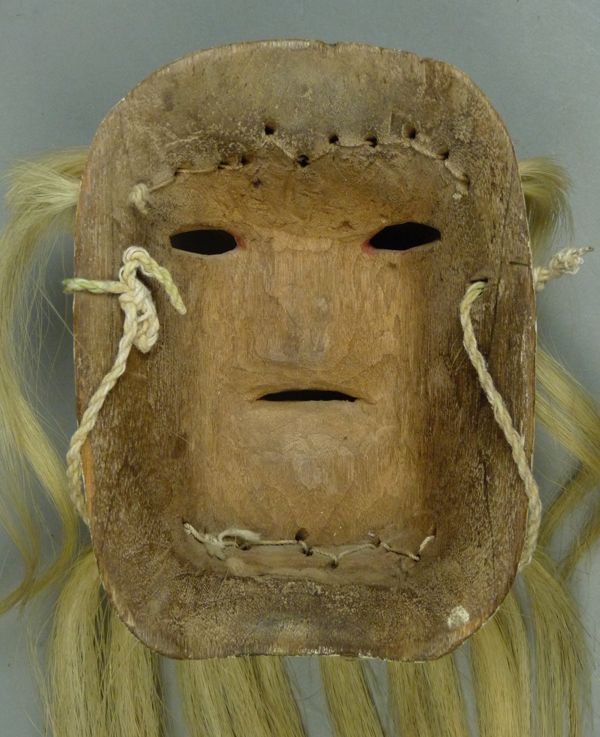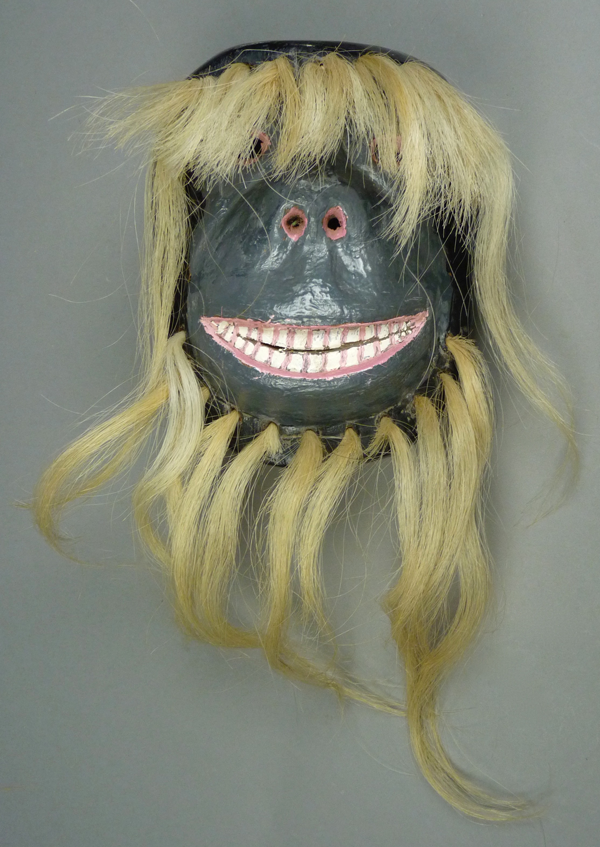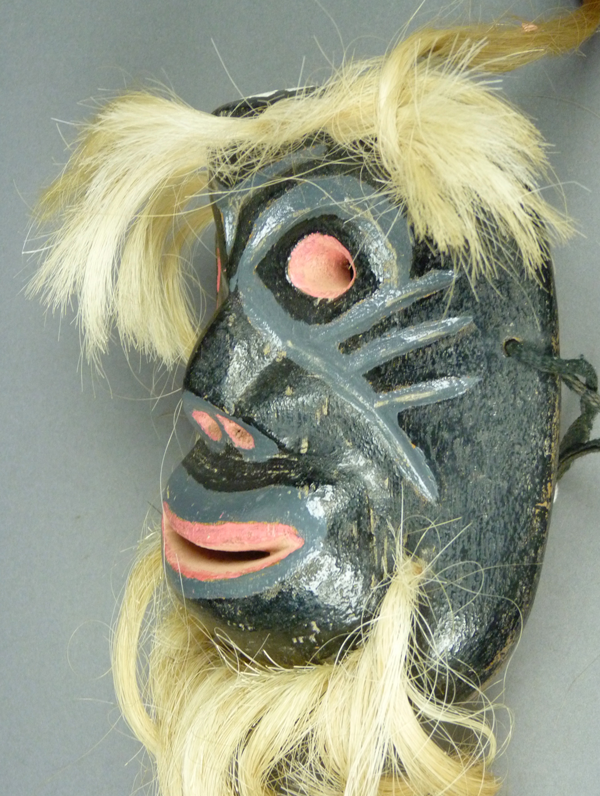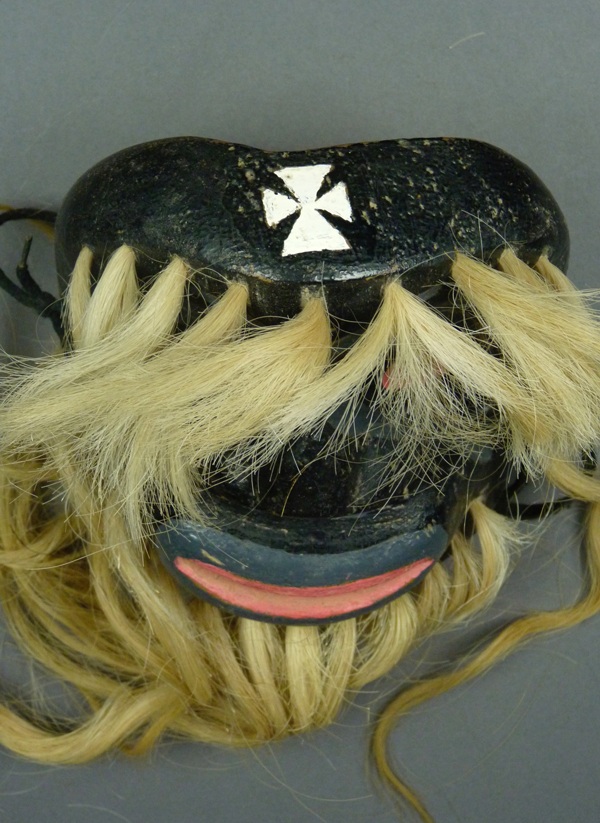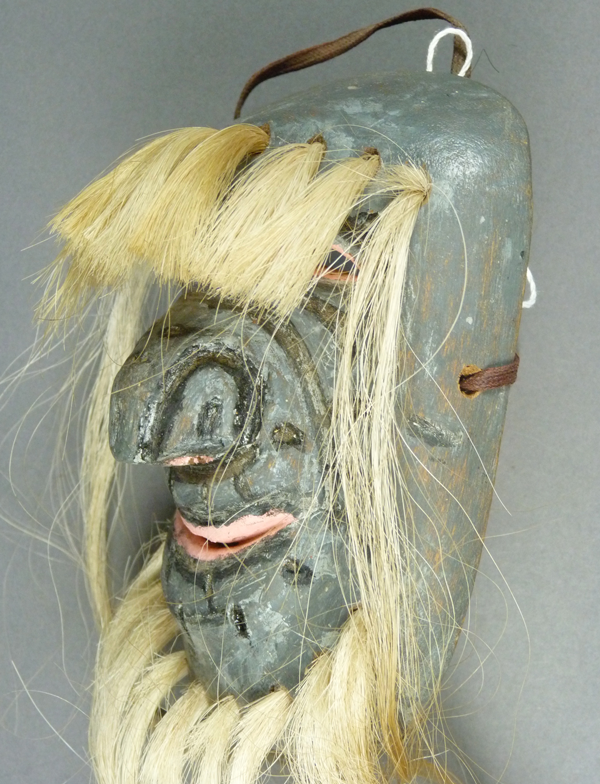This series of posts about Yoeme (Yaqui) Pascola masks began on July 4, 2016.
In June, 1988 I bought my first Yaqui Pascola masks from Robin and Barbara Cleaver. So far you have seen two of those masks—a human faced Pascola by Román Borbón and a goat by Alejandro Reyes Alegria. I bought today’s Yaqui Pascola mask from the Cleavers in 1990. All three were initially anonymous, and as with the other two, I became curious to learn the name of the carver of this mask. I confess that I pestered my friend Tom Kolaz for years with erroneous ideas that he rejected, and eventually I accepted the likelihood that this was one mask that would probably remain anonymous. Here is that mask, which probably dates to the 1960s or 70s.
Because of the lolling tongue and the informal paint I thought of Antonio Bacasewa and Inez “Cheto” Álvarez as the possible carvers; I will introduce Cheto’s masks in a later post.
This is an old mask, and over the years it was probably repainted; I doubt that the blue paint was original to the mask.
The top of this mask is relatively flat. Note how the forehead cross spills over onto the rim design; the cross was probably repainted.
There is a cross on the chin but this may not be original, given my suspicion about the blue paint, and furthermore the chin cross also collides with what was probably the original rim design.
This mask is 7 inches tall, 5 inches wide, and 3¼ inches deep.
The shape of the back of the mask is a striking feature. It is so rectangular, but rounded at the corners. There is staining of the wood to suggest very long use, while the strap is relatively new.
I stopped trying to discover the identity of the carver, and years passed. Then Tom showed me photos of an old man in Potam, Sonora who had carved some unusual masks, including two that depicted monkeys or apes, along with some others. That carver’s name was Gerardo Barcelo Matus. At first glance none of these masks made me think of my mystery mask. Tom was willing to sell me one of the apes, since it was a near duplicate of the other that he planned to keep. When I received that mask I was shocked to discover that it had some features in common with the mystery mask after all. I will show you my ape Pascola mask and then I will explain.
This is a terrific ape mask.
One notices the flat top. Indeed this mask has a flat band that goes around the entire edge.
I was surprised to find the cross favored by Alejandro Reyes Alegria. However, he was from the same town and probably Geraldo and Alejandro were friends.
This is a friendly ape.
There is a small Christian cross on the chin that was apparently original to the mask, as Tom Kolaz’s agent obtained it directly from the carver.
This mask is 7 inches tall, 5½ inches wide, and 2¼ inches deep.
The back has the same unusual shape as my mystery mask. This back has been varnished, probably to reduce the risk of infestation by wood boring insects.
When I photographed the mask collection of Barney Burns and Mahina Drees I was delighted to see that they had found some additional masks like the ones that been obtained by Tom Kolaz, and these masks even came with essentially the same carver’s name, but with various spellings (Geraldo or Gerardo Barcelon, Barcelan, or Barcelo). This next mask from their collection appears to be another ape.
Carved grooves simulate wrinkles, in the manner of Román Barbón’s Viejo masks.
This mask has the very flat top that we found on the other ape mask.
I don’t believe that this mask had a chin cross.
The back of this mask has that same shape, even including the indentation at the chin. It was collected in 1995 after several years use. Parts of the back have been sanded.
The next example from the collection of Barney Burns and Mahina Drees seems to depict a Viejo, an old man, with carved wrinkles. Notice that the top of this mask is not so flat compared to the two apes; this is a variable feature.
This forehead cross is not unlike the one on the Mystery mask, assuming that the blue paint surrounding that cross was added later.
This mask has that same cross on the chin.
Here is a detailed view of the frowning face of this Viejo.
Again one sees that this carver has a typical manner of carving the back, but yet there is some variation in the details. This mask was carved in 1997 and collected in 2006.
The next mask was identified as the work of Silverio Aquileras of Potam, Sonora. I believe that this attribution is erroneous, and that Gerardo was actually the carver. Here is the mask, see for yourself.
On this mask we see now familiar carved wrinkles.
The hair on this mask is of similar quality to that on the other masks.
Unfortunately I somehow neglected to take a photo of the back of this mask, but the view of the forehead provides a fairly convincing comparison.
Here is the last of this series of masks from the collection of Barney and Mahina in this style. It was identified at the time of collection as a mask by Gerardo Barcelon.
This mask has a very subtle extended tongue, not so large and dramatic like the one on the mystery mask.
This mask has a broad flat top, much like that of the mystery mask. There is a forehead cross of glitter.
There are also glitter crosses on the cheeks, but none on the chin.
The back of this mask is very similar to that of the mystery mask. It was collected in 2006, but was said to date back to about 1978, the same era as the mystery mask.
From this evidence, I am inclined to attribute my old mask to Geraldo/Gerardo Barcelo Matus.
Next week I will introduce you to the masks of Manuel Centella Escalante, of Potam.





